Filigree scrollwork hits exactly in the right place between art history and tattooing in modern times. Extracted from the intricate style of baroque wooden carving, the use of leather in the West, and ornaments made of metal, these filigree tattoos can serve in a variety of ways: the whole sleeve , the classy sleeve filler , or the artistic picture-frame around the portraits, the eyes, or the flowers. I previously discussed 27 different methods, their construction, suitability ( mens and women ), placement ( shoulder , back , chest , neck bushiness), and the kind of outfits that make each design shout. Just a small personal note: my first experience sitting for ornamental work taught me the hard way that contrast is king-dense scrolls need negative space to breathe. So keep that in mind while you read.
1) Gothic portrait framed in baroque curls
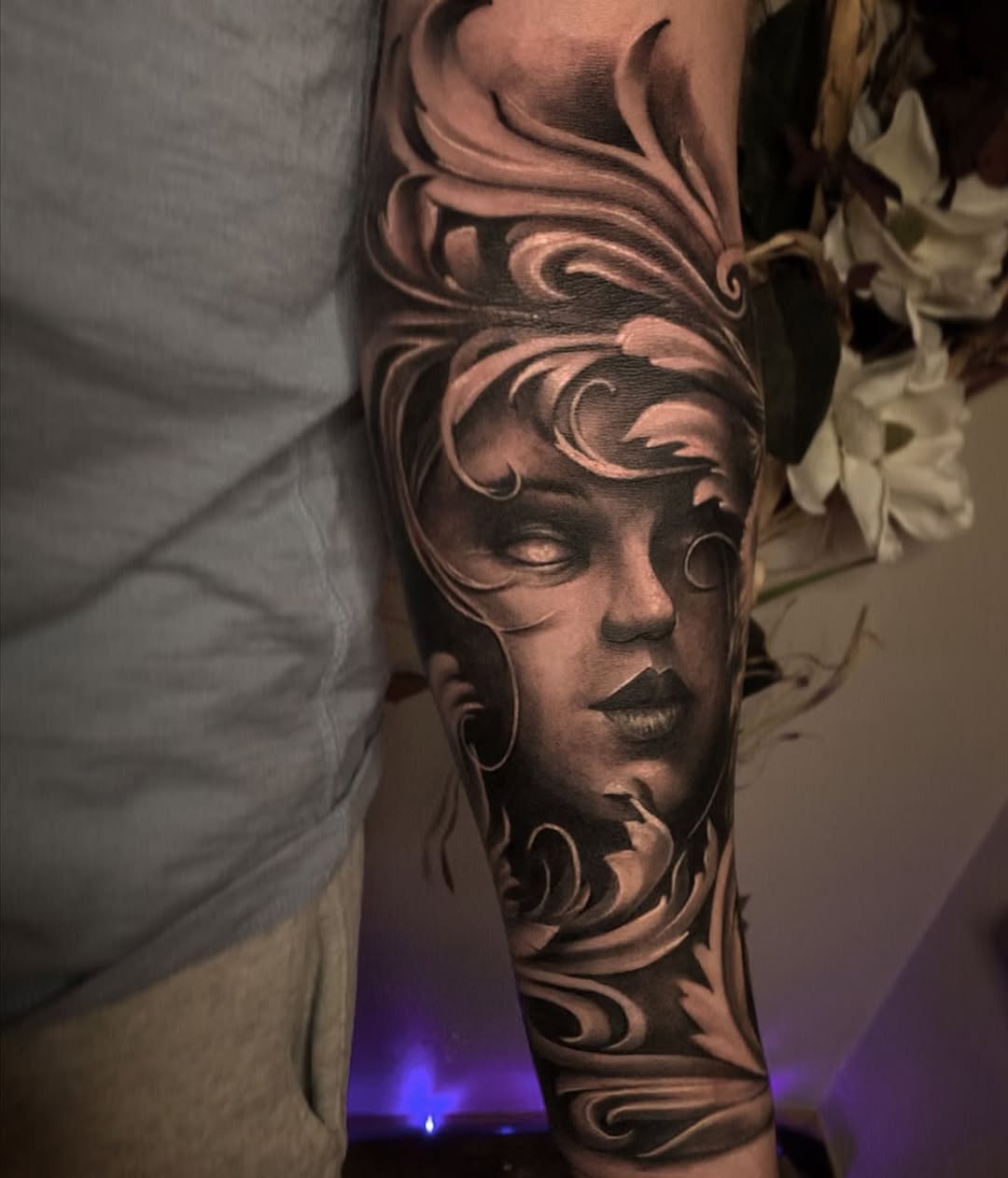
This forearm tattoo combines black-and-grey realism with baroque ornamental curls that twirl like wood carving. The blind-eyed female figure evokes a gothic atmosphere; silky whip-shading brings the cheekbones forward while crisp bevel highlights give the scrolls a truly three-dimensional appearance.
It’s a powerful cornerstone for a designs sleeve : these S-curves can go up the shoulder and onto the chest for a cathedral-like panel.
Reason: deep black packing behind the portrait creates negative space that separates skin-tone scrolls from facial planes.
Best for: mens or women who want a dramatic hero motif without color.
Outfit styling: short-sleeve knit polos, cropped leather jackets, or rolled denim emphasize the forearm’s taper; matte silver rings echo the cool greys.
2) High-contrast sleeve filler with warm scrolls
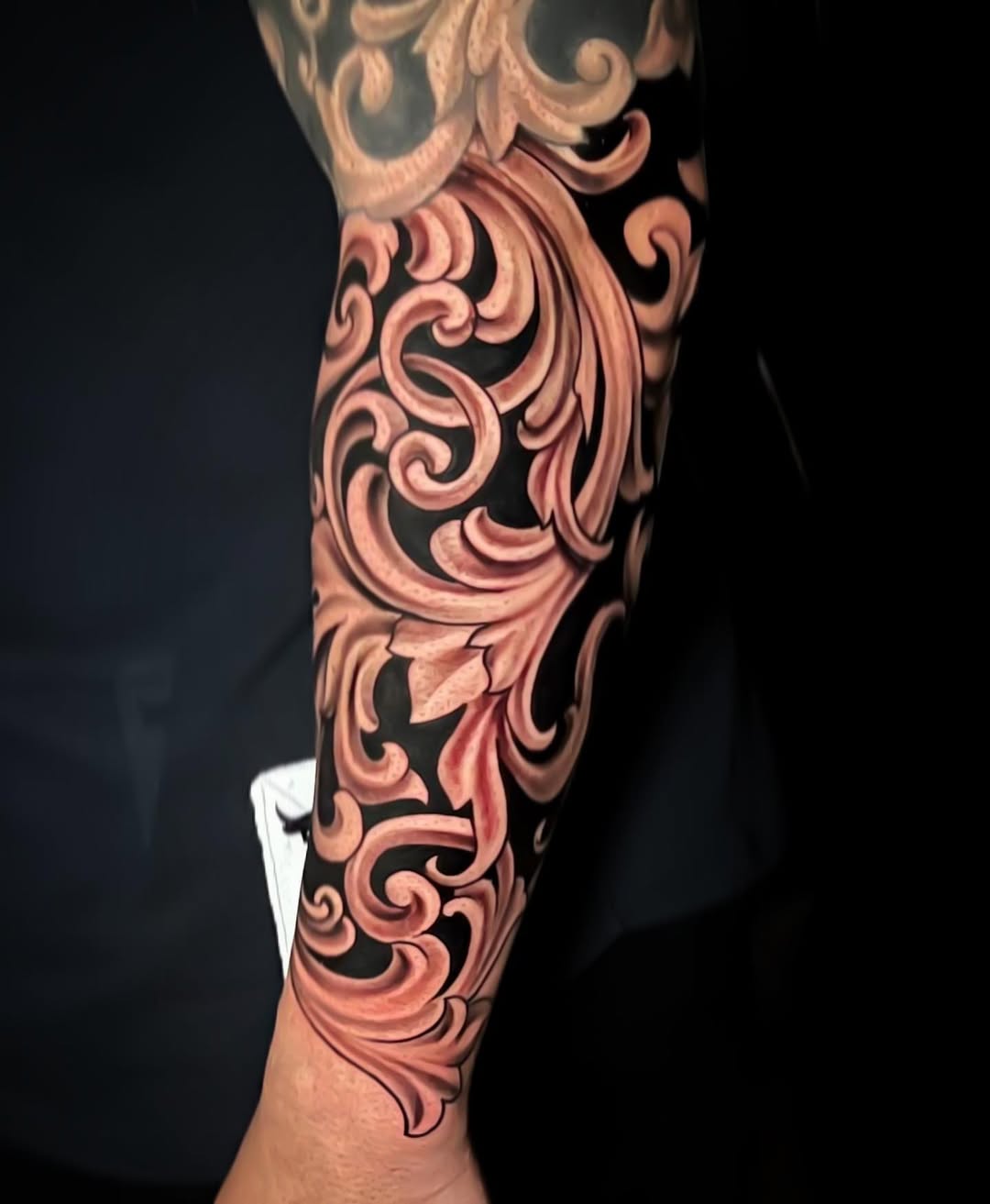
Here the artist pushes a near-black backdrop so the scrollwork reads like oiled mahogany. The negative-to-positive rhythm is perfect sleeve filler when you need to connect existing pieces.
Notice the smooth bevels: they’re drawn as if light skims from one direction, which helps every curl “pop.”
Why it works: disciplined light source, clean outer edges, and zero mid-value mush.
Placement notes: inner or outer forearm; scales cleanly onto back or shoulder panels.
Outfit styling: black tees or dark overshirts make the warm scrolls glow; a minimal steel watch won’t fight the curves.
3) Western-inspired calf scroll
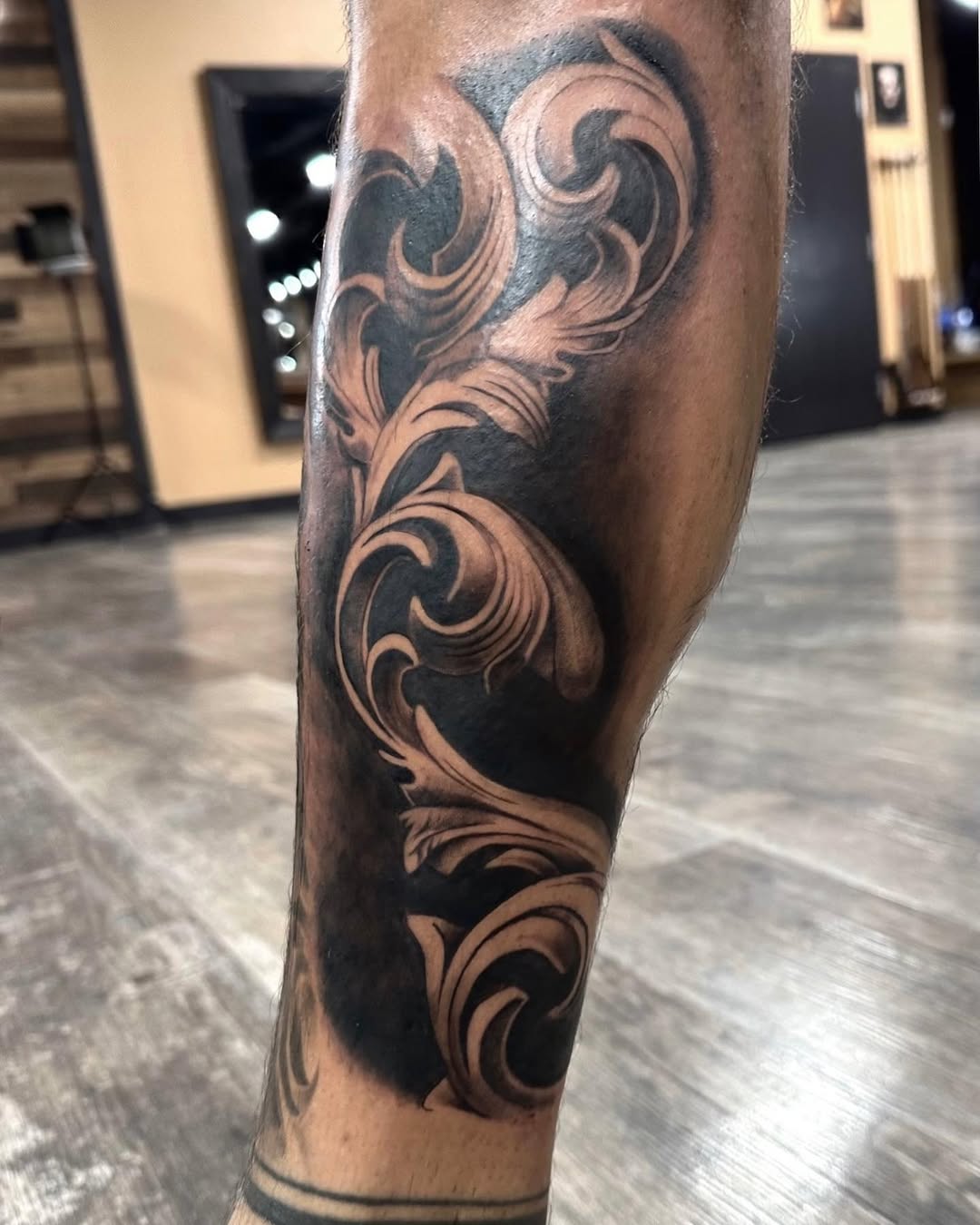
This leg piece rides the calf with a long, tapered S-curve—classic Western leather-tooling energy translated into tattoo. The soft transitional greys prevent the filigree from looking sticker-flat, while the black field behind the tips adds lift.
Why it works: single dominant curve fits the anatomy; nothing feels crowded when the shin flexes.
Build ideas: mirror a second ribbon on the lateral calf or tie it into a back of knee medallion for motion.
Outfit styling: cropped trousers or cuffed denim; engineer boots pair especially well with Western -leaning designs .
4) Fine-line filigree with carved-wood texture
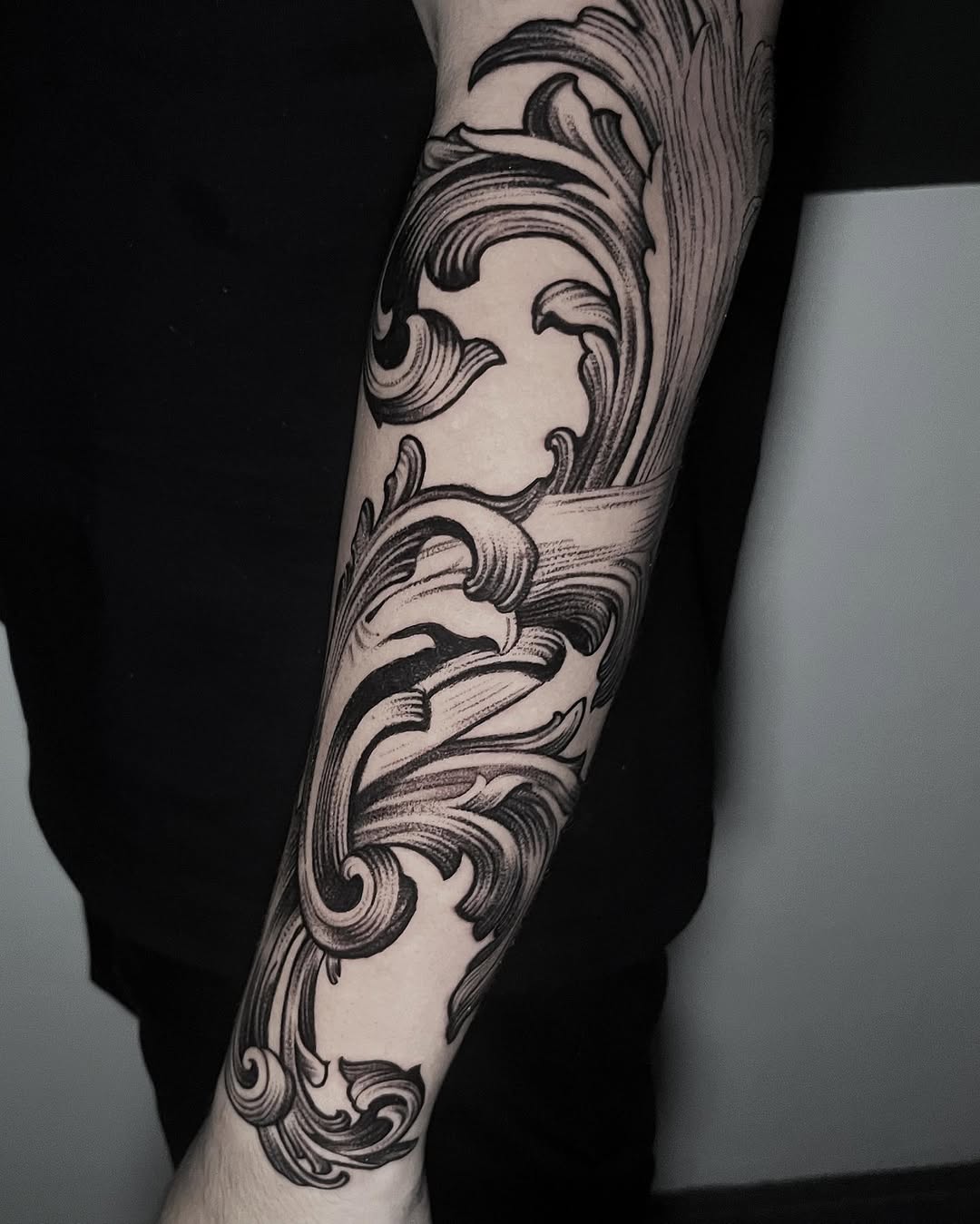
A monochrome, fine line approach that looks sketched and hand-carved rather than airbrushed. Cross-grain hatching inside the leaves mimics wood striations; bold outlines only appear where structure needs support. It’s a superb starting point for stencil lovers who want to see the graphic read before adding heavier shading.
Why it works: line-weight hierarchy—thicker on the outside, hairline inside—keeps it elegant and dainty despite its size.
Placement notes: forearm now; expand to neck caps or chest collar “wings” later without changing style.
Outfit styling: light oxford shirts with rolled sleeves; the ink’s graphite feel pairs nicely with grey tailoring.
5) All-seeing eye framed by scrolls
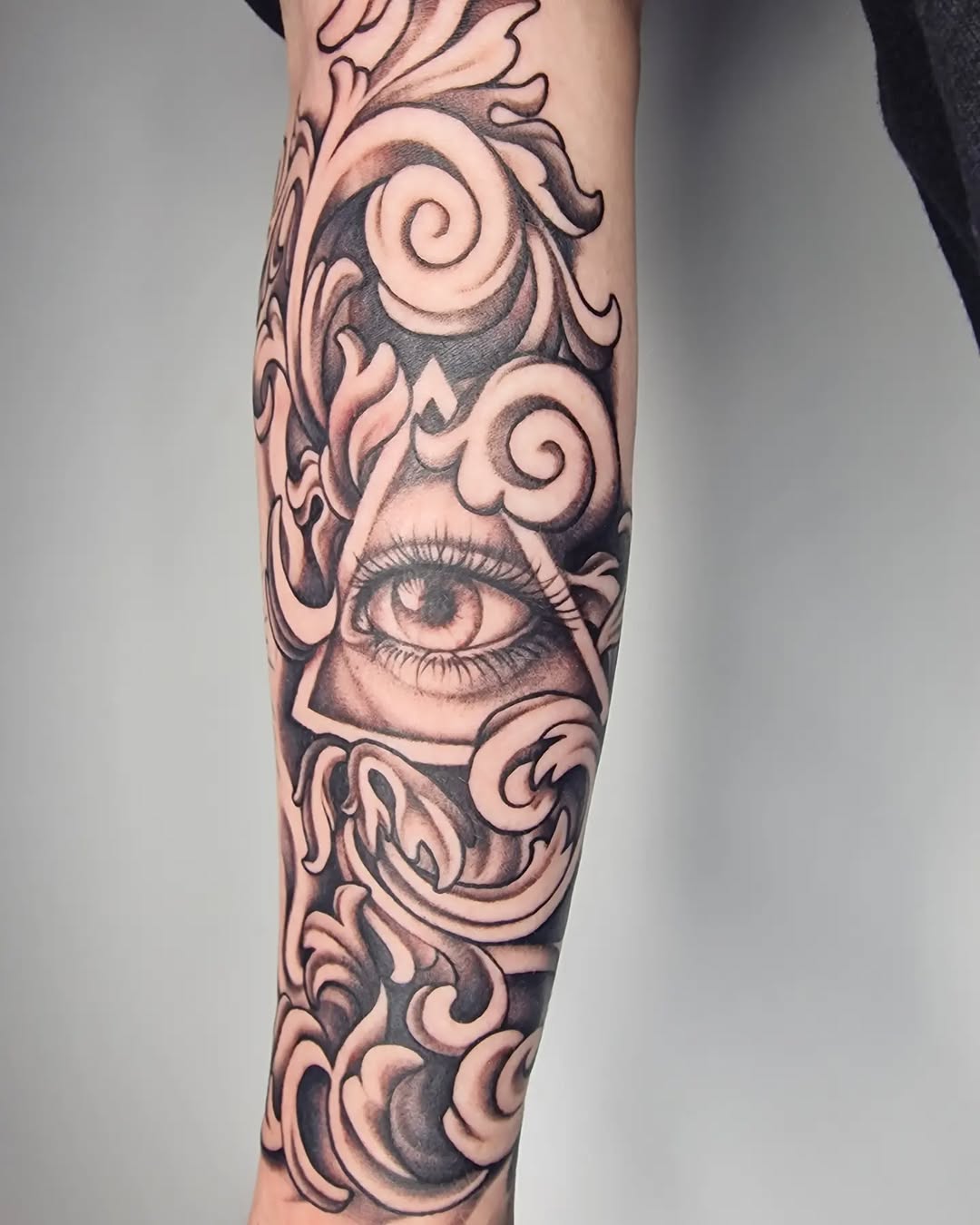
A hyper-detailed eye sits inside a triangle and breathes through champagne-toned scrolls. The symbolism leans gothic and esoteric without going full horror. Microtextures around the iris contrast with the smooth filigree, giving the viewer a crisp focal point.
Why it works: focal-point realism (the eye) plus simplified baroque curls = legibility from across the room.
Sleeve plan: ladder the scrolls toward the shoulder ; drop smaller curls as filler to transition into existing floral or geometric work.
Outfit styling: charcoal or cream knits keep things elevated; avoid loud prints that steal attention from the eye.
6) Heirloom-rose warm greys on the inner forearm
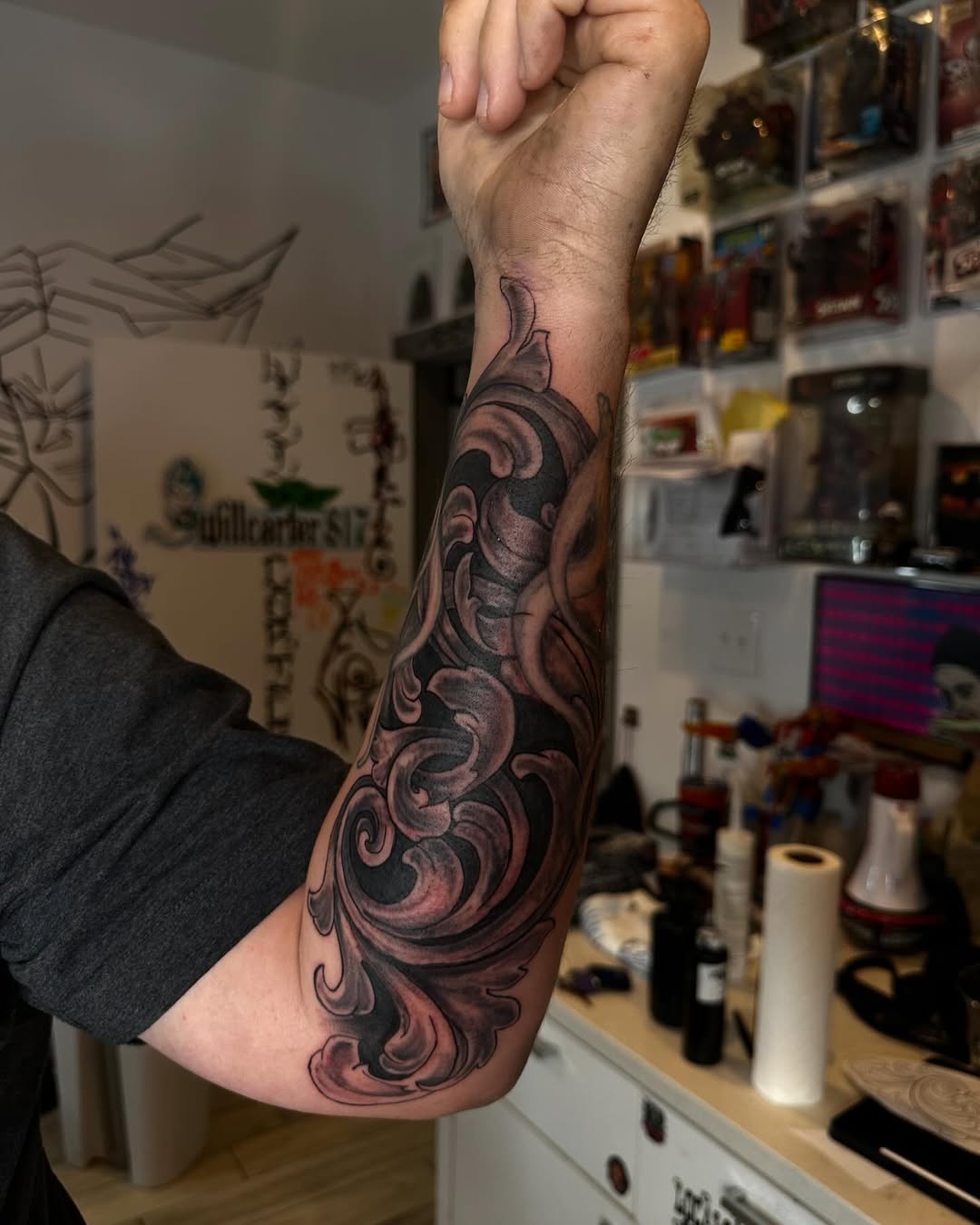
Warm greys with a blush undertone make this scroll look like aged bronze. The inner forearm placement lets the largest lobe sit near the wrist crease, then the design fattens up toward the elbow for balance—a classic sleeve builder.
Why it works: subtle mid-tone tinting adds life without color; the soft bevels feel almost satiny.
Expansion paths: bridge to a chest plate via elbow cap curls; or run a back -of-arm tendril to frame the triceps.
Outfit styling: earth-tone tees, suede jackets, and copper jewelry echo the warmth.
7) Knee-cap baroque with devotional accent
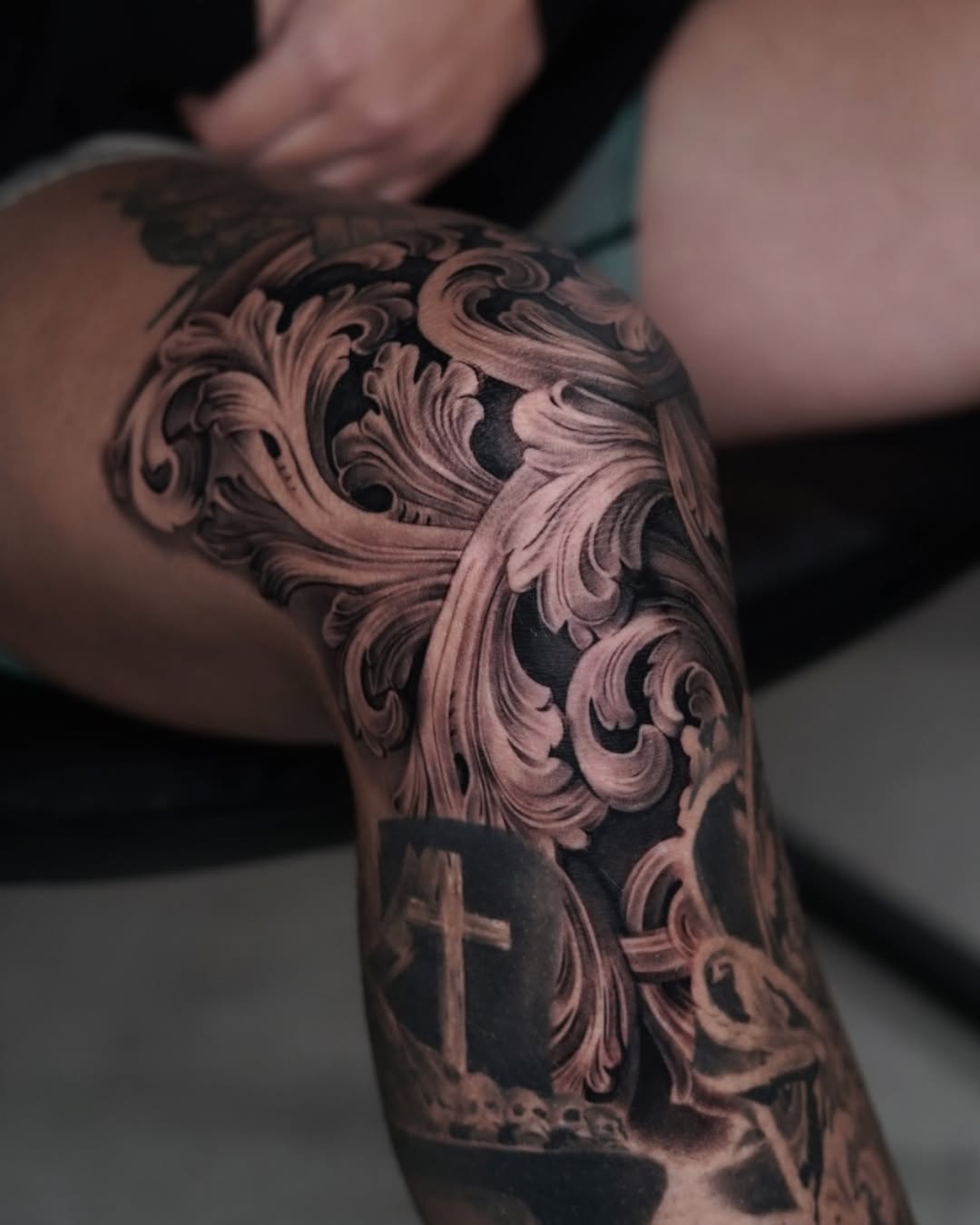
This is a masterclass in flow over a tough joint. Broad acanthus leaves arc around the patella so the scrolls open when the knee bends and lock together when the leg straightens. The dense, matte black behind each lobe is packed carefully to avoid blowouts on the thin skin over the kneecap. Below the main cluster sits a devotional vignette—cross and bones rendered in soft black-and-grey—that reads as a secondary panel without stealing attention from the ornamental mass.
Why it works: the dominant C-curve is placed above the knee line, then smaller tendrils cascade down the tibia to create motion. The leaf ribs are bevel-shaded, giving a carved-wood illusion that screams Baroque and ornamental craft.
Build ideas: bridge a slim ribbon up the thigh to meet a designs sleeve on the hip or back of thigh; echo that cross motif on the chest or inner arm for narrative unity.
Comfort & healing tip: compression leggings reduce friction the first week; keep squats light until the flaking phase ends—knees take a beating.
Outfit styling: cropped athletic shorts or raw-hem denim show the architecture; heavyweight socks and chunky sneakers balance the visual weight.
8) Forearm sleeve scrolls with warm-grey bevels
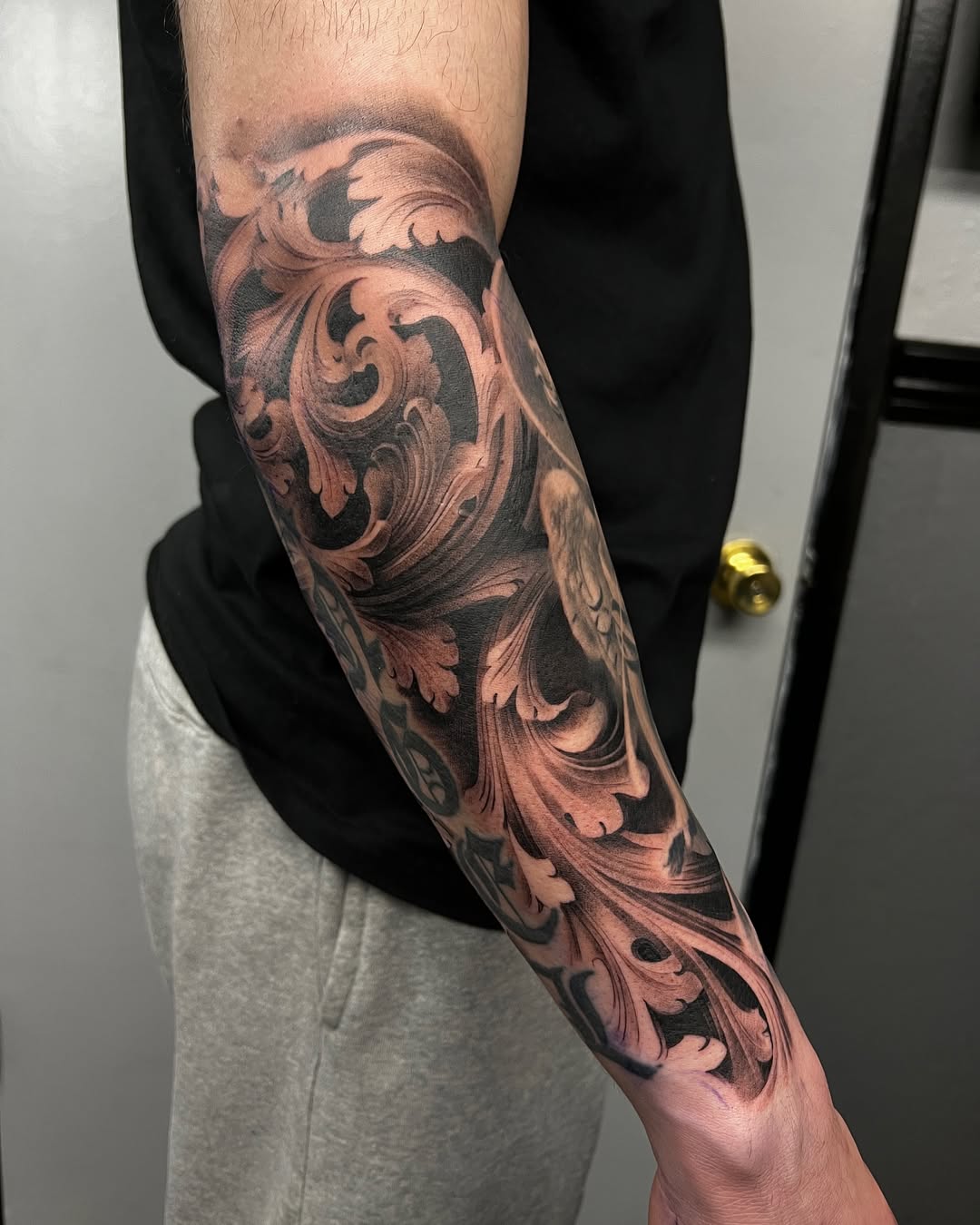
The inner-to-outer forearm transition is handled with sweeping S-curves that widen as they approach the elbow, then narrow into delicate tips at the wrist crease—perfect sleeve filler that can later tie into shoulder or neck caps.
The palette leans warm: mid-tones are softly feathered so the lobes look like aged bronze against a velvety black field. Look closely at those negative micro-gaps between leaves; they’re intentional “air vents” that keep heavy filigree from turning muddy.
Why it works: consistent light source from the dorsal side of the arm; highlight ribbons are placed on the same edge of each curl, so the scrolls read as one object in real space. Line-weight is minimal—shading does the heavy lifting—so the piece feels premium and not cartoony.
Expansion paths: add a fine line floral cluster near the antecubital to soften the geometry; or run a narrow ornamental ladder to the back of the arm for a wraparound sleeve .
Outfit styling: black tees and oatmeal hoodies make the warm greys glow; a brushed-steel bracelet mirrors the bevels without fighting the curves.
9) Full baroque sleeve that climbs from wrist to shoulder
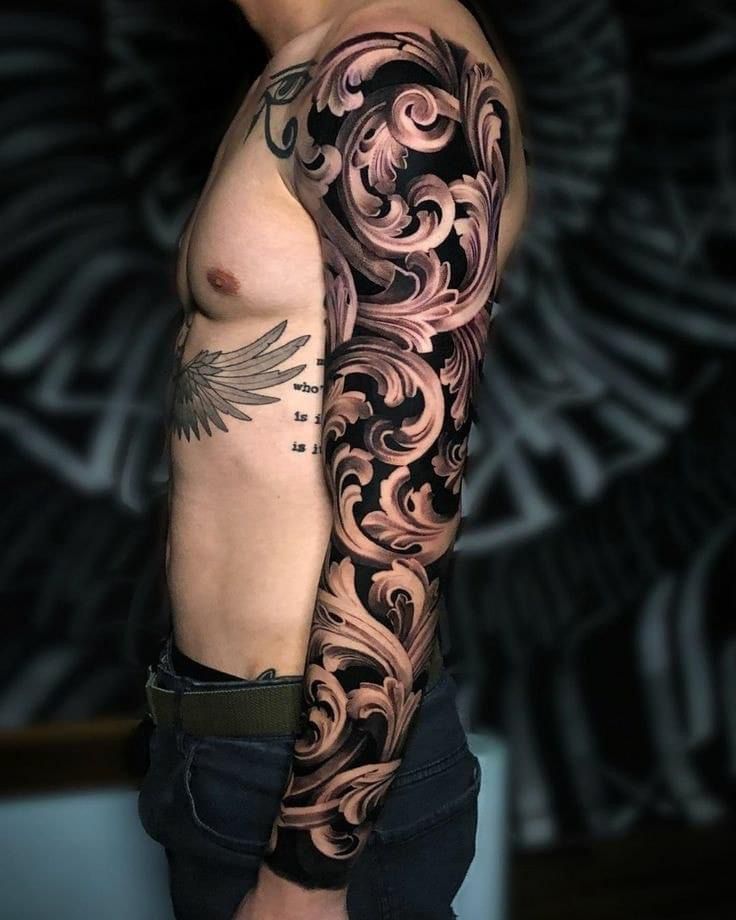
A masterclass in designs men architecture: heavy black packing makes the warm acanthus look carved and polished, then the scrolls widen over the deltoid to form a shield-shaped cap. The rhythm is deliberate—tight curls at the wrist for finesse, broad lobes at the shoulder for power—so the whole sleeve reads from across the room. Ask your artist to keep highlight ribbons consistent; that single light source is what sells the beveled “wood” effect so beloved in baroque and ornamental work.
Build & style: If you plan a chest tie-in, mirror one large S-curve across the clavicle. Styling-wise, fitted black tees and dark denim let the contrast breathe, while a matte belt buckle echoes the satin greys.
10) Black-and-grey forearm scroll with airy shading
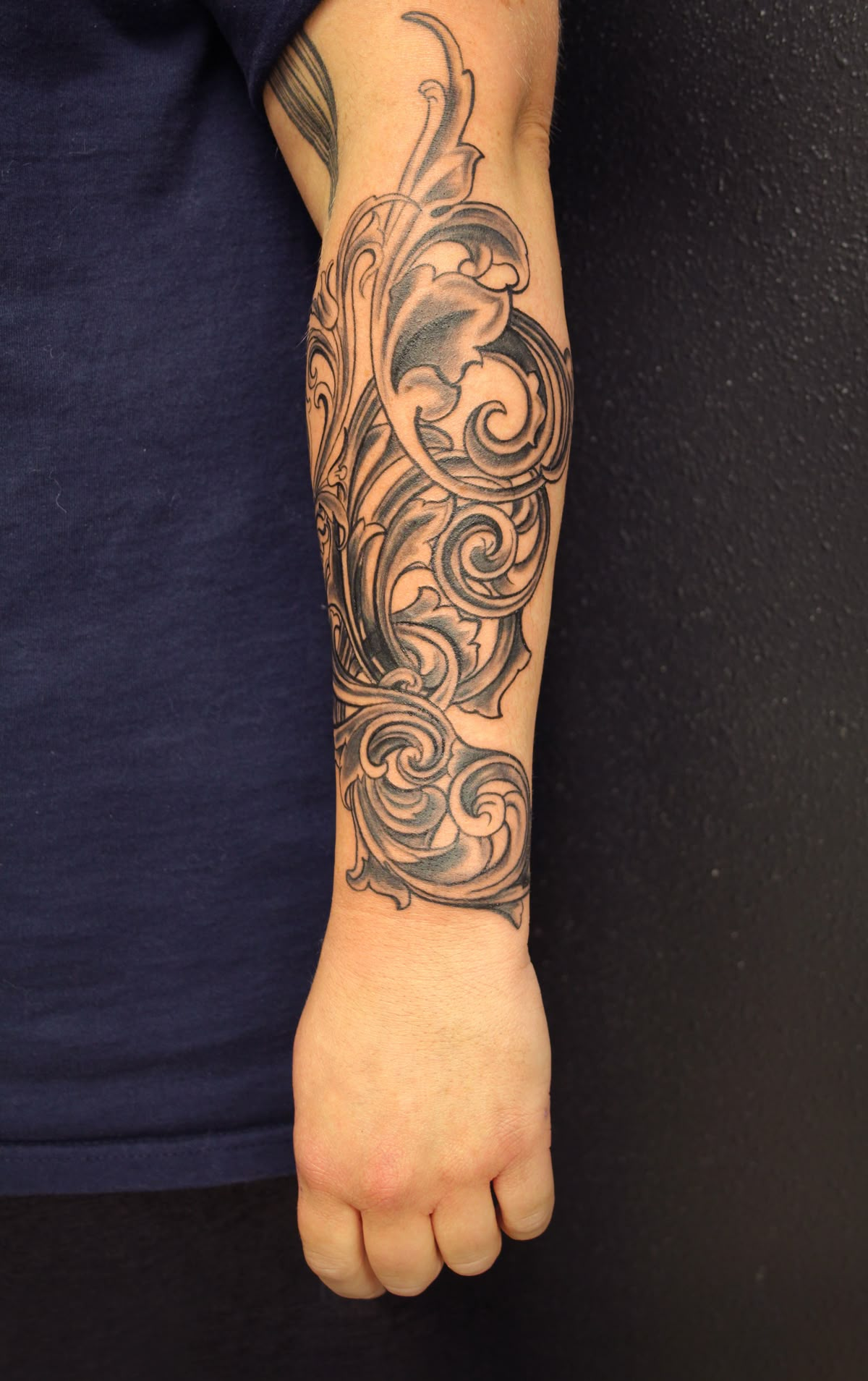
This forearm composition uses soft pepper shading instead of solid fields, perfect if you want movement without max contrast. Look at the ribbed midribs inside the leaves—those serve as a built-in stencil map, so enlarging the motif for a back or shoulder panel stays true to the texture. It’s a versatile sleeve filler for mens and women alike.
Build & style: Add a fine line rosette near the wrist bone to taper the sweep. Works great with rolled chambray sleeves and a slim, brushed-steel watch.
11) Dainty, fine-line filigree with botanical lift
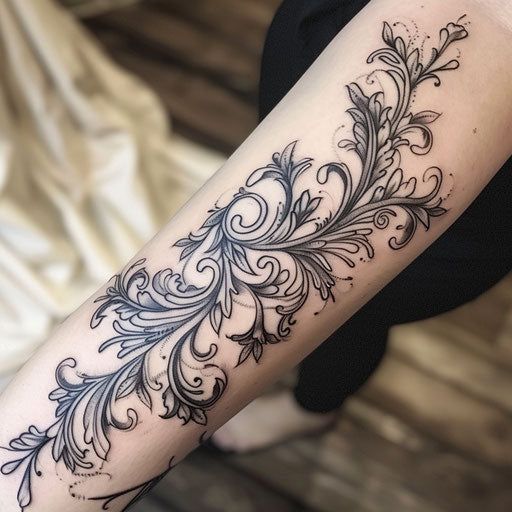
An elegant, dainty take: needle-light outlines, micro leaves, and just enough grey to separate layers. This reads almost floral without actually being flowers—ideal for women who want grace over muscle. Because the negative space carries the design, it plays beautifully across bony landmarks like the inner forearm or collar.
Build & style: Keep it clean—thin bangles, silk tanks, and neutral knits. For future sessions, you can ghost in a second pass of smoke-light shading to add depth without losing delicacy.
12) Full negative-space sleeve with feminine flow
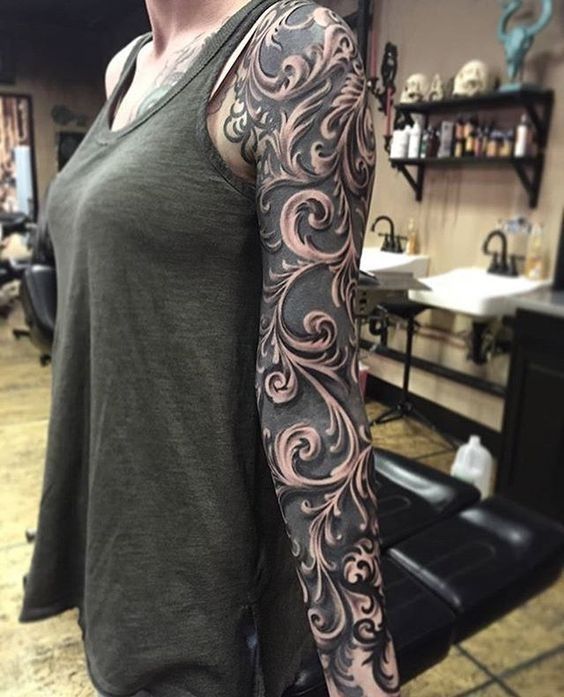
Here the artist leans on broad charcoal fields so the filigree glows like rose-gold against velvet. The placement respects anatomy: crescents cradle the elbow pit; long stems track the radius so the scrolls elongate the arm. A refined option for women who still want a commanding designs sleeve .
Build & style: Consider a soft neck cap of three curls to frame a scoop-neck top. Outfits in olive, tan, and charcoal pull warm mid-tones forward; avoid busy prints that compete with the scroll rhythm.
13) Architectural filigree with graphic banding
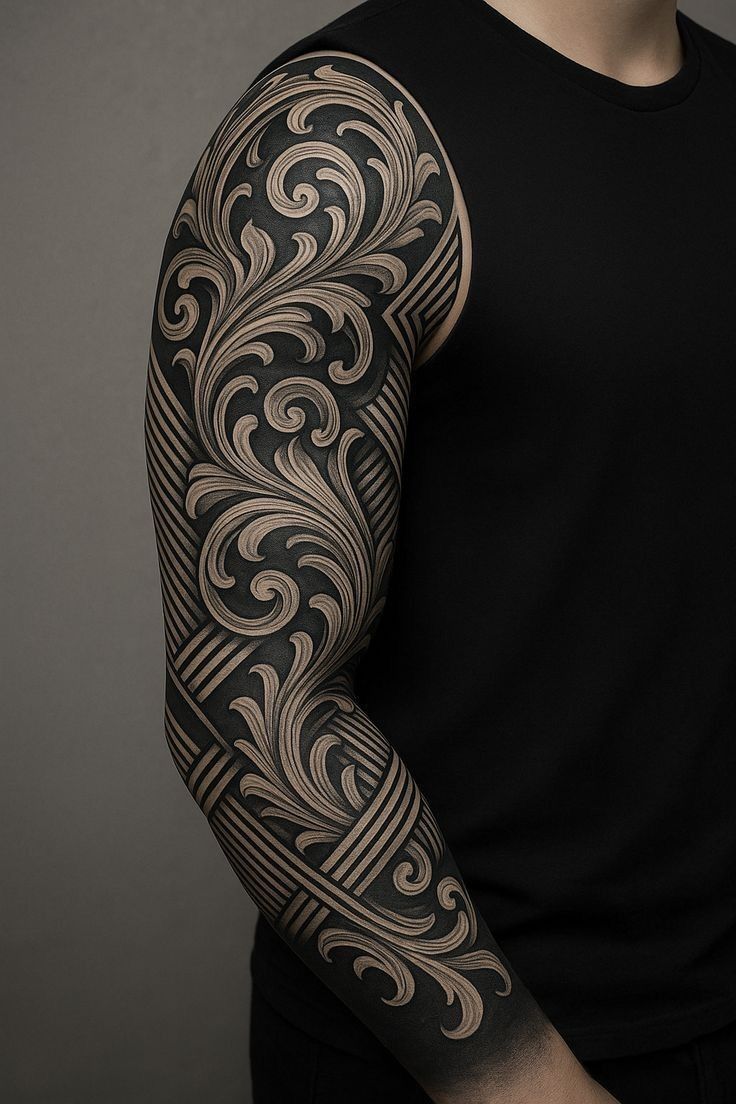
A contemporary spin: classic acanthus meets disciplined linework bands that behave like basket-weave inlay. The geometry gives your sleeve pauses—visual “rests” that keep ornate sections from feeling dense. This layout is fantastic for stencil outline men planning because every band is a clean landmark for future add-ons to chest or back .
Build & style: Carry two bands across the biceps into a pectoral strap for armor energy without going literal. Pair with minimalist streetwear—black tees, cropped jackets, zero logos—to let the structure speak.
14) Narrow plume scroll as surgical sleeve filler
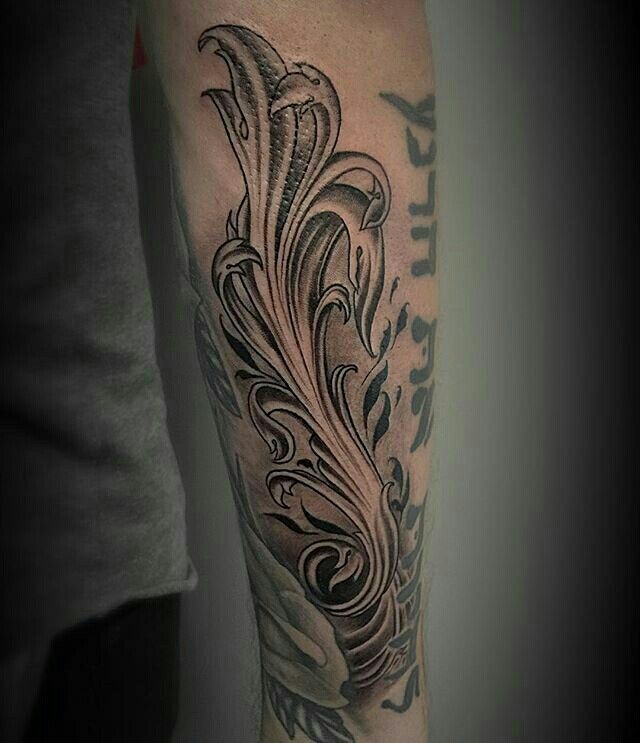
This tall, feather-like plume is the definition of strategic filler . It slips between existing script and shapes, adds motion toward the wrist, and keeps edges crisp with tiny negative slivers. Textured cross-hatching along the spine nods to western leather carving while staying fully ornamental .
Build & style: Repeat a slimmer echo plume on the inner forearm to create a call-and-response. Works with cuffed flannels and utility vests—rugged textiles give the warm greys a handsome counterpoint.
15) Clean stencil forearm with airy scrollwork
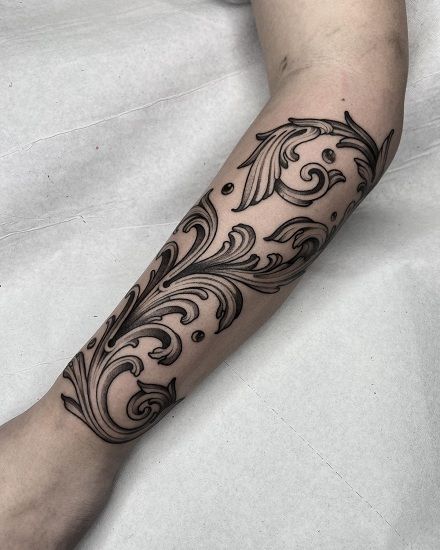
A crisp stencil -first approach that celebrates line. The acanthus spine runs wrist-to-mid-forearm, with beadlike pearls to punctuate the negative space. Because the outlines are confident and the fine line interior ribs are already mapped, this is an ideal day-one pass before adding soft bevel shading later. Think of it as scaffolding for future filigree tattoos .
Why it works: one dominant S-curve carries the flow, while secondary curls steer around veins and tendons so the design doesn’t “fight” the arm.
Styling tip: pair with pared-back metal jewelry; the graphic black will do the talking.
16) Portrait-meets-ornamental full sleeve
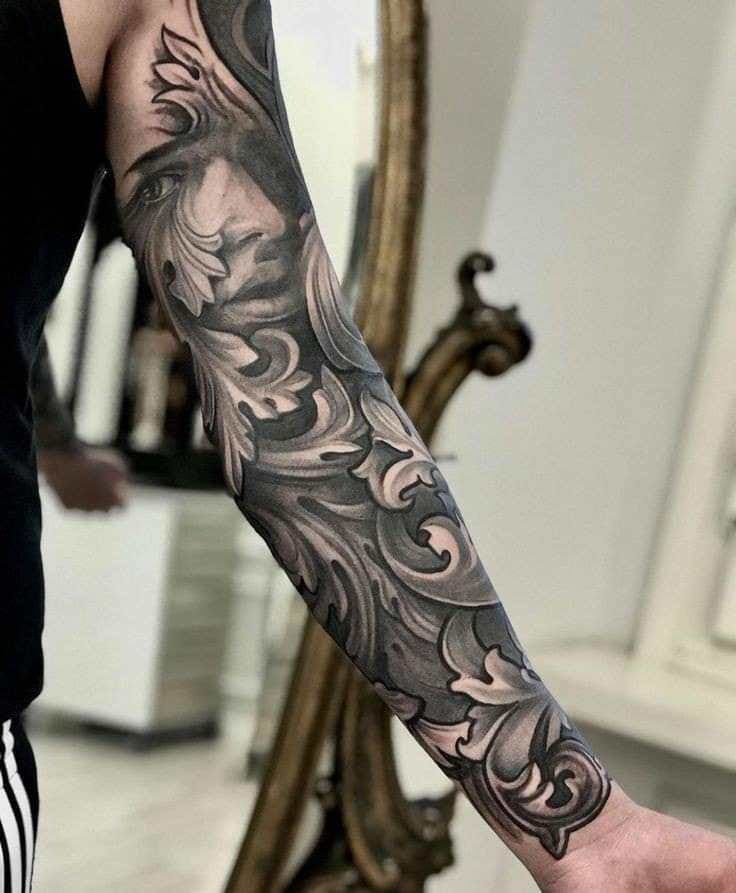
A moody face emerges from carved scrolls—classic gothic romance wrapped in a sleeve . Dense blacks behind the acanthus give the skin-tone lobes a bronze sheen, while the portrait supplies a focal point that reads from across the room. This is the kind of designs sleeve that anchors a whole upper-body plan.
Build ideas: echo a few curls over the shoulder and onto the upper chest so the portrait feels housed inside an architectural frame.
Styling tip: black tanks or ribbed knit tees keep highlight ribbons crisp under indoor light.
17) Baroque calf panel with cathedral depth
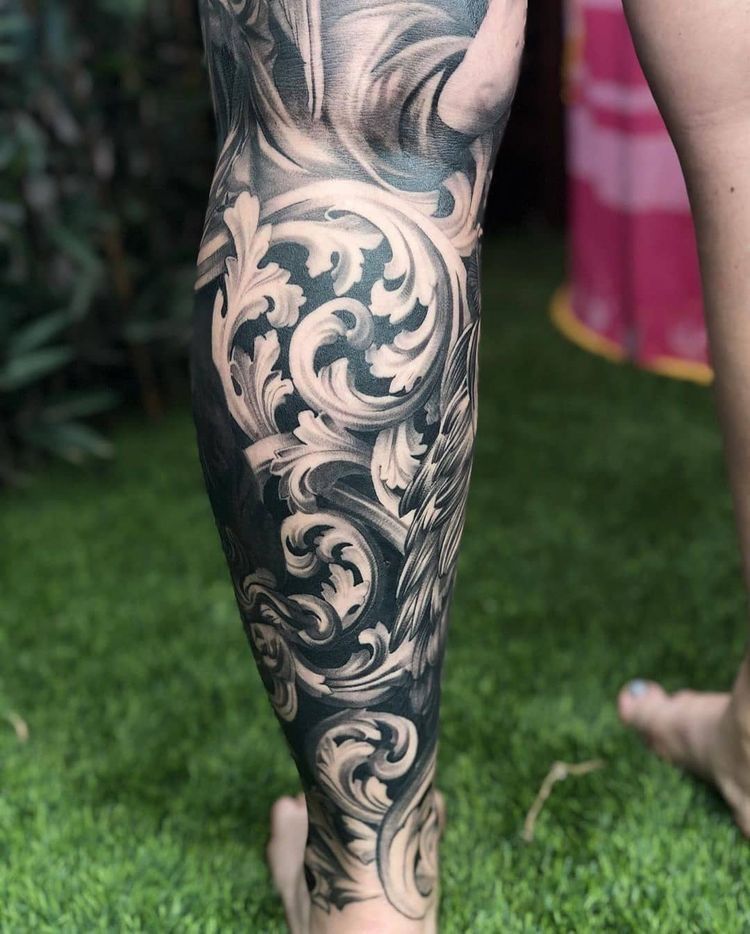
Opulent scrolls climb the calf like carved choir stalls. The artist uses wide, velvety reservoirs of black to separate leaves, then feathers mid-tones toward the Achilles to keep the ankle light. It’s a leg-forward answer to designs men who want grandeur without saints or skulls.
Flow note: the broad lobes sit on gastrocnemius bulges so they bloom when you walk—filigree that literally moves.
Styling tip: cropped trousers, leather loafers or boots; the warm greys love earthy materials.
18) Full-length linework leg with lace energy
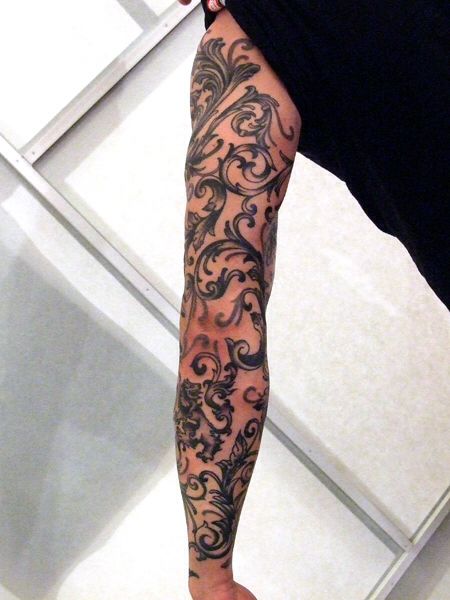
A long, lace-like ribbon of scrolls runs from thigh to ankle. Minimal fill, maximal rhythm—great for clients ( women or mens ) who prefer breathable ink and fast healing. Because it’s largely fine line , you can later weave in soft smoke or drop-shadows where the anatomy needs lift.
Expansion: add a narrow filigree ladder at the inner thigh to connect toward the lower back or hip.
Styling tip: airy skirts or athletic shorts; this reads elegant, not heavy.
19) Wrist micro-panel with hatch texture
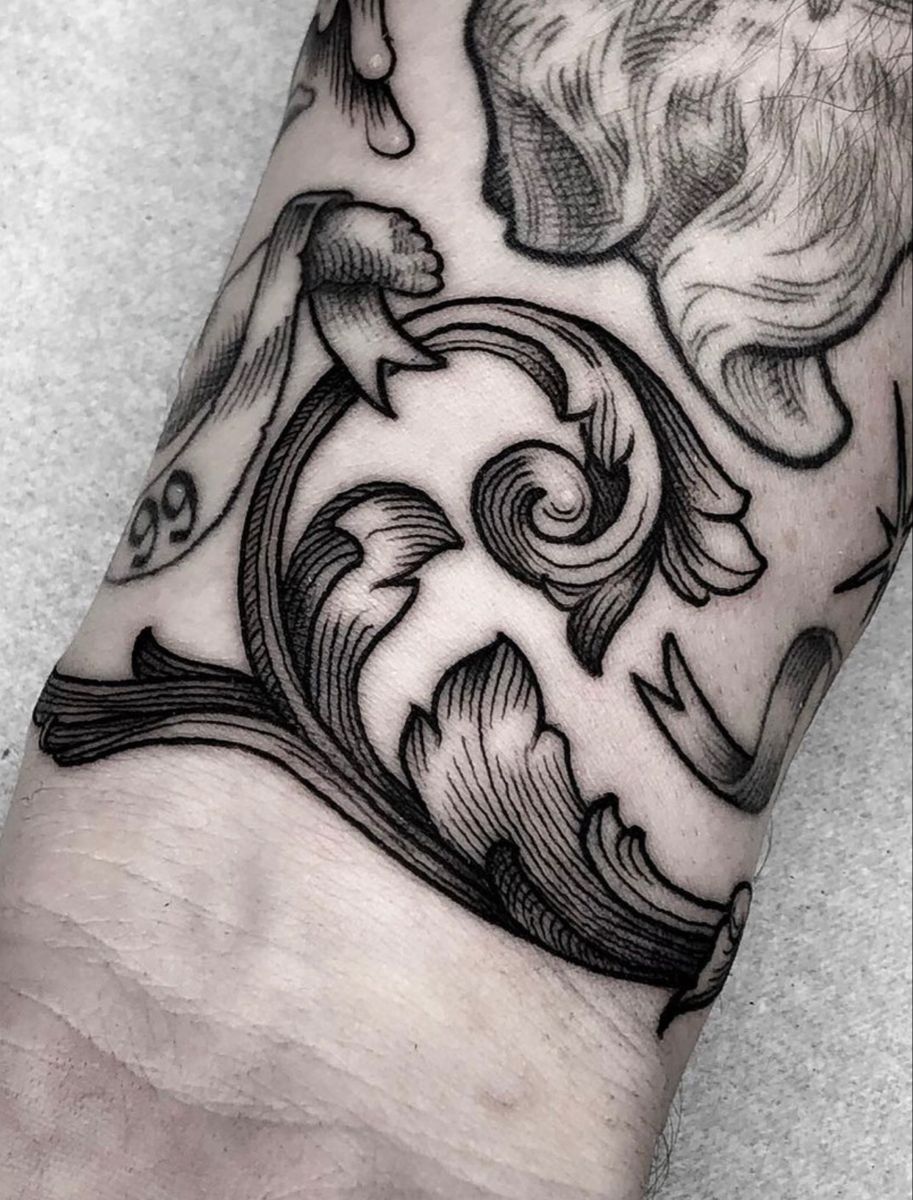
A tight, palm-sized flourish perfect as filler or a punctuation mark at the end of a sleeve. Cross-hatching inside the lobes mimics wood grain; the outer edge stays bold for durability over a high-motion zone. This is how to add craft to a busy composition without stealing focus.
Placement: tucks under bracelet lines; pairs nicely with floral sprigs nearby for contrast.
20) Volumetric plume on the lower forearm
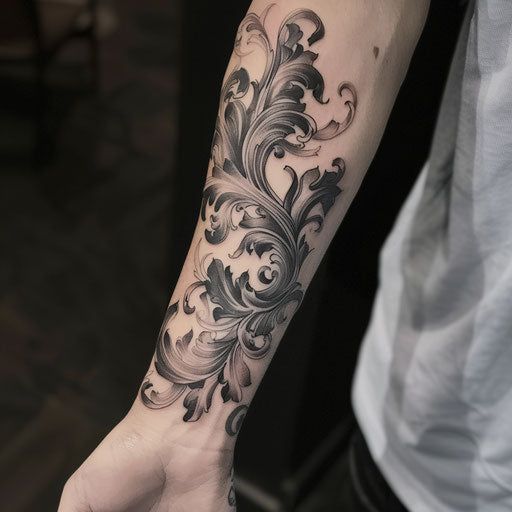
A single plume fans upward from the wrist crease, shaded like satin. The greys are pillowy, then the tips resolve to sharp points—high drama without clutter. Use this as strategic sleeve filler between script or symbols, or as the seed for a future wrap that climbs to the shoulder .
Artist note: keep a consistent light source (dorsal or ulnar) so every bevel agrees; that’s what makes ornamental read “carved.”
Styling tip: neutral knits and a slim watch; the glow of the mid-tones will show under soft light.
21) Pebble-bevel forearm with velvet blacks
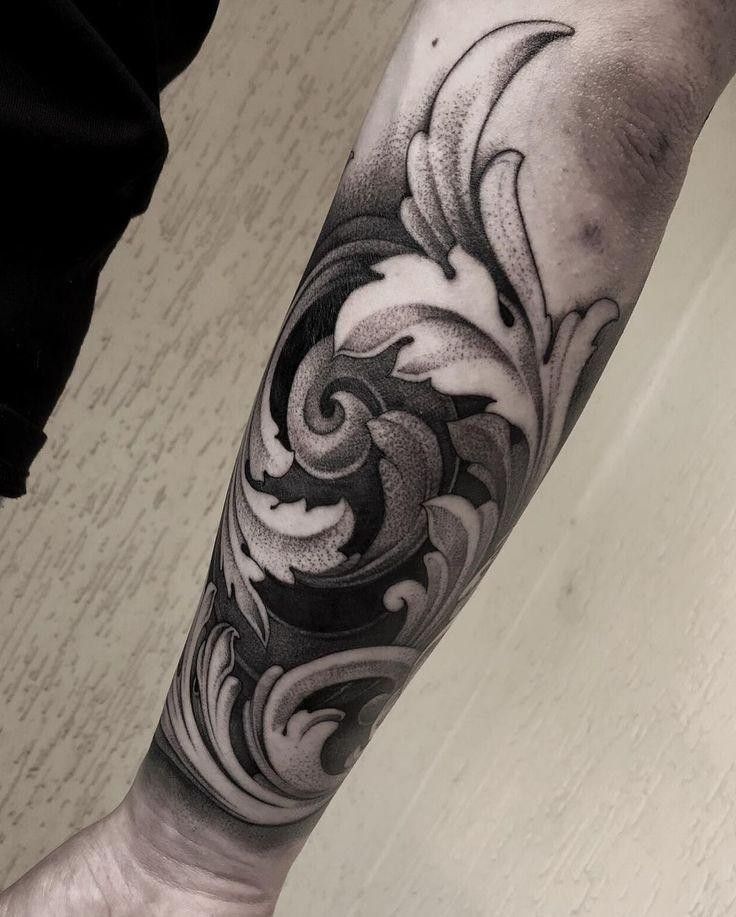
A tight corkscrew of acanthus rides the inner forearm, shaded with a “pebble” stipple that reads like carved limestone. The velvety reservoirs of black behind the lobes create dramatic lift—classic ornamental contrast without looking plastic. The bevel highlights stay on the ulnar edge so every curl agrees with a single light source.
Why it works: stipple in the mid-tones prevents muddy healing and gives longevity on a high-motion area.
Styling tip: ribbed black tee or hoodie, brushed-steel bracelet—let the greys glow.
22) Feathered dotwork filigree with botanical grit
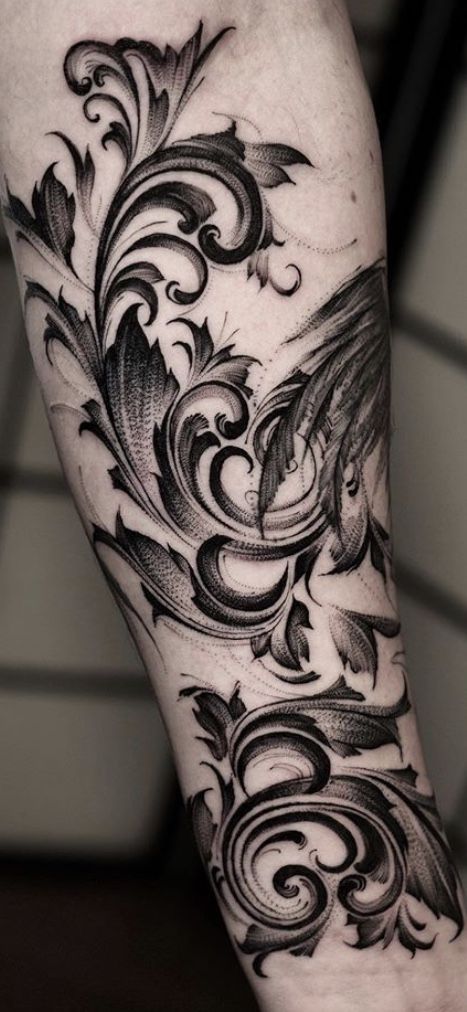
This piece mixes crisp coils with dot-packed feather textures—a bridge between fine line craft and painterly shading. The leaf ribs are etched first (great stencil roadmap), then the artist smokes dots outward to soften the edges. It’s a versatile forearm module for mens and women that scales beautifully into a larger sleeve .
Build ideas: add a muted floral bud near the elbow crease for a natural pause before the next scroll.
23) Minimal twin flourishes for subtle elegance
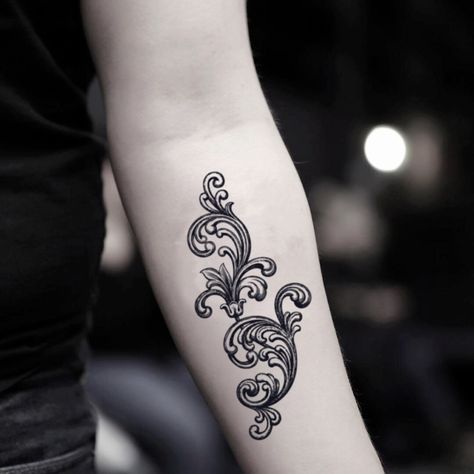
Two petite S-curves, no fill—pure line rhythm. This is the dainty option that still reads filigree tattoos from a distance. It tucks neatly on the inner forearm, side of the neck , or collarbone edge; healing is fast and maintenance light.
Style note: pairs with thin bangles or a slim watch; negative space is the luxury here.
24) Shoulder-cap cascade with satin mids
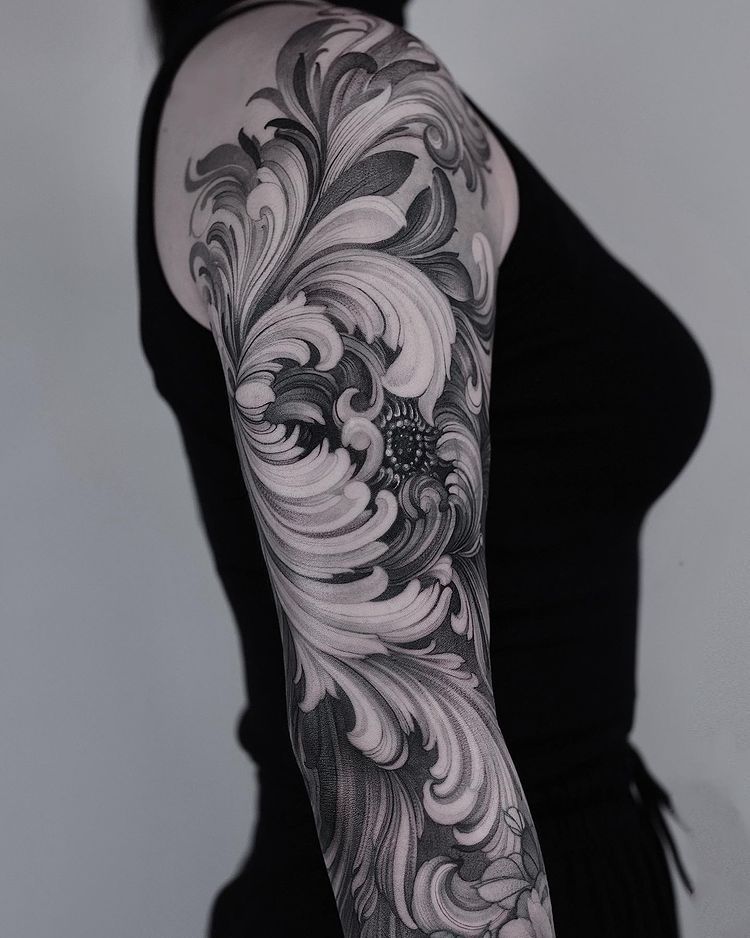
A lush shoulder cap spills down the arm like draped fabric. The mid-greys are satin-smooth; micro-pearls at the core add sparkle without clichés. It’s grand but wearable—perfect as a statement sleeve starter that can later bridge to chest panels or an upper- back medallion.
Why it works: wide lobes sit over the deltoid’s dome; narrow tips taper into the biceps so the arm looks longer.
25) Lacework line sleeve with breathable negative space
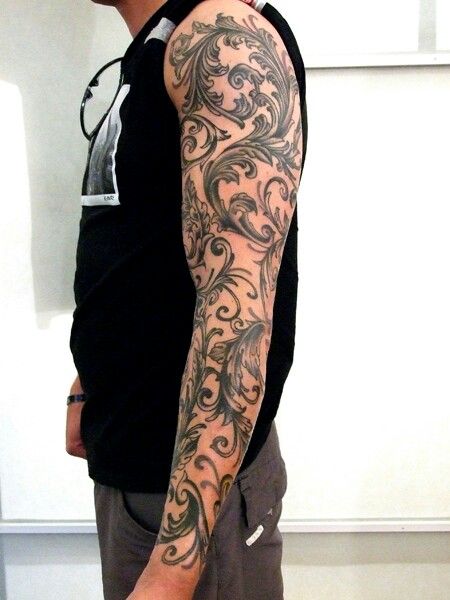
All the romance, none of the heavy packing. This long sleeve reads like wrought-iron lace—ideal for clients who want movement and fast healing. The scrolls weave around tendons and bony landmarks, keeping the arm athletic rather than bulky.
Outfit pairing: tank tops, linen shirts, and soft athleisure; the airy linework loves light fabrics.
26) High-polish bronze illusion on the forearm
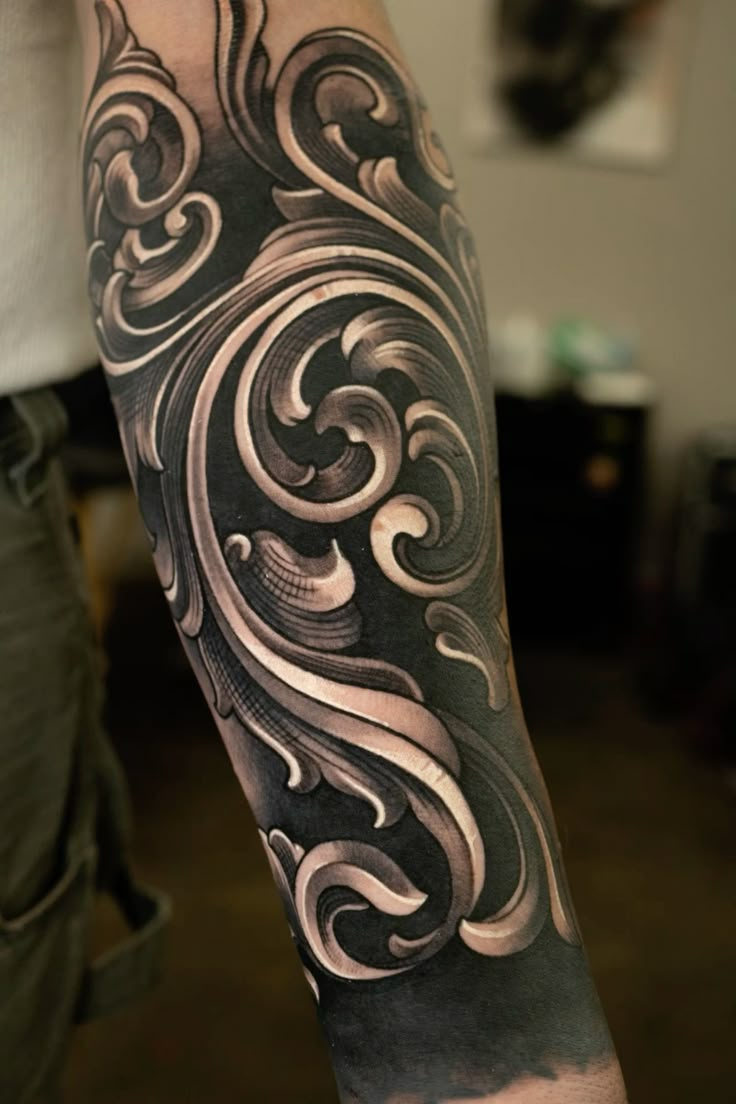
Here’s the “carved bronze” look done right: dense charcoal shadows, razor-clean edges, and reflective highlight ribbons that track consistently. The lower edge fades into soft soot so you can either finish at the wrist or continue toward the hand later. A premium choice for designs men who like precision.
Build ideas: add a narrow band or rosette at the wrist as a visual “stop,” then echo that on the upper shoulder for balance.
27) Pepper-shaded plume with dynamic grain
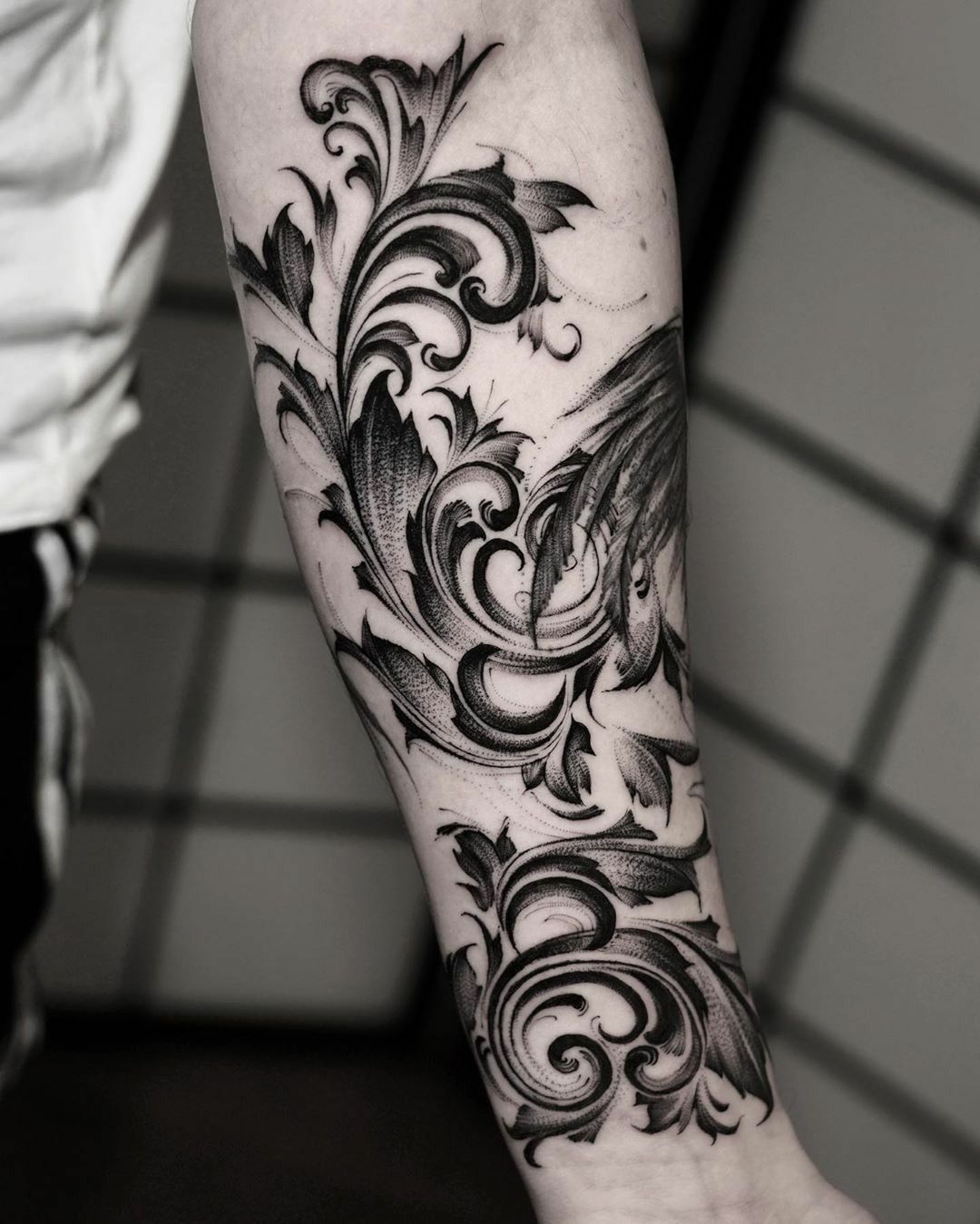
A sweeping S-curve unfurls from the wrist and blooms into layered acanthus—classic ornamental filigree with a modern twist. The artist maps crisp outer lines like a clean stencil , then builds volume with pepper shading and directional grain so each lobe looks hand-carved. Tiny negative slivers between curls act as air vents, keeping the composition readable as it heals. This module is perfect as sleeve filler in a black-and-grey designs project, and scales well for mens or women forearms.
Why it works: a single light source—high and ulnar—puts consistent bevel highlights on every tip, while the dotwork mids stop the greys from turning muddy.
Expand it: add a fine line floral rosette near the elbow crease for a soft pause, or ladder a thinner ribbon toward the shoulder to start a full sleeve .
Styling tip: neutral knits and a slim steel bracelet echo the cool tone of the shading without competing with the baroque curves.
Filigree is one of those languages the body speaks fluently: a single S-curve can lengthen a forearm, a carved shoulder cap can feel like armor, and a thin dainty flourish can whisper where a full sleeve shouts. Whether you lean gothic and dramatic or fine-line and breathable, the secret is rhythm—consistent light, smart black “reservoirs,” and enough negative space for the scrolls to breathe. Treated this way, ornamental work ages beautifully and frames anything beside it, from portraits to floral clusters.
I’d love to hear how you’d wear it. What placement are you considering—forearm, shoulder, chest, neck, or a full designs sleeve—and what mood fits you best: baroque drama, western grit, or delicate fine line?
